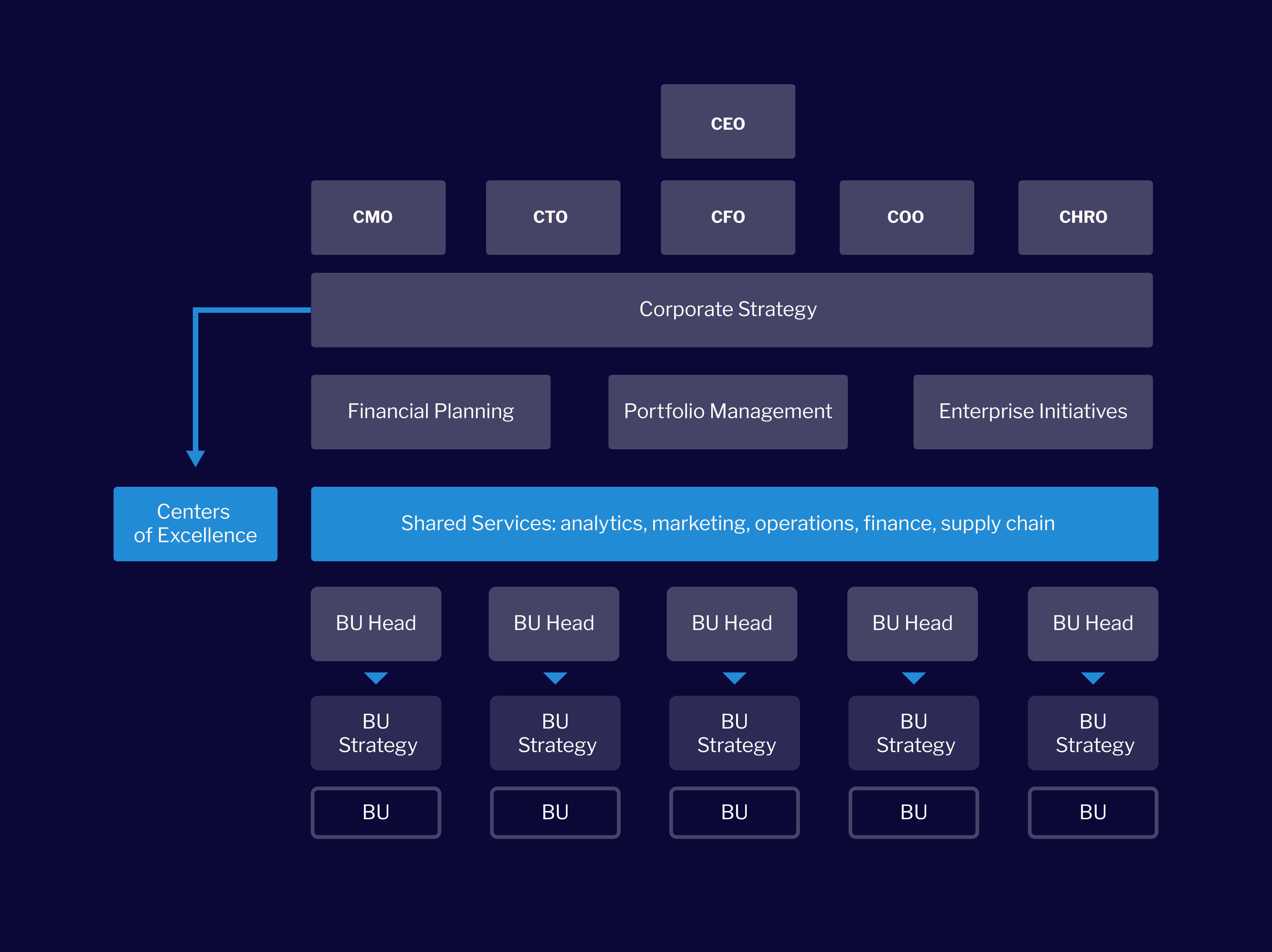Everything You Need to Know About Centers of Excellence
Access to expertise is more important than ever.
“Rising inflation, labor shortages, supply chain disruptions, and changing consumer behaviors are the high-impact events that are top of mind for CEOs and other C-Suite executives.” According to a 2022 Gartner® CEO Survey, CEOs’ greatest priorities for 2022 are growth (overall expansion and scaling), technology (digitalization, e-commerce, and cybersecurity), workforce (talent retention, hiring, and DEI), and corporate (M&A, strategy refresh, and restructuring). Most notably, “workforce” has moved up in the ranking of priorities since 2020 by 32%.
One of the most impactful ways executives will respond to these challenges is with “innovative human capital management.” Today’s most dynamic and innovative leaders know access to expertise is more important than ever and that they must adopt an agile and strategic approach to talent management and skill set resourcing. An effective approach to accomplish this is by establishing a center of excellence (CoE).
Center of Excellence Definition: What is a center of excellence?
A center of excellence is a group with a shared area of focus and subject matter expertise that they use to support others, usually by providing tips, insights, training, and research. They may standardize best practices for company-wide adoption and offer advice on strategic planning, decision-making, and execution.
According to Gartner, centers of excellence are, “A physical or virtual center of knowledge concentrating existing expertise and resources in a discipline or capability to attain and sustain world-class performance and value.” They usually involve internal stakeholders, internal and/or external subject matter experts, as well as employees who typically execute work.
For example, imagine marketing leadership across different product lines is charged with forming a CoE to implement best-in-class social customer care for your customers. You might bring in external experts, like independent consultants or subject matter experts (SMEs), to help leadership determine how they can best offer training, tips, and resources for the teams.
Internal leadership and external supporting players can then provide the insights and knowledge gathered to the people who are executing the work that needs to be done, which might comprise internal and external resources. You may also need project management support from internal or external resources. Leveraging internal and external resources in a blended manner is a critical aspect of CoE work.
Centers of excellence help optimize how work gets done. That’s why you may hear them being referred to in a variety of ways including but not limited to:
- Global business services/multifunctional shared services
- Global Insourced Center
- Global shared services organization
- Competency center/global competency center
- Capability center
Types of Centers of Excellence
There are different types of centers of excellence — based on your needs, you can establish one for any department or business unit. Here are some common examples of areas of the business that may benefit from a CoE.
- Internal consulting
- Supply chain
- Quality assurance
- Business analytics
- Artificial intelligence (AI)
- Robotic process automation (RPA)
- Internet of Things (IoT)
- Digital transformation
- Finance and accounting
- Human resources
- Agile development
- Innovation
- R&D
- Operations
How do CoEs drive value for organizations?
Many benefits come from having a center of excellence. They can add value to organizations in numerous ways across all business units due to their specialized subject matter expertise and operational agility.
Before we review five specific benefits of centers of excellence, take a look at the main mission areas a center of excellence can be leveraged in — this will also provide insight into how they can deliver value to your organization.
Primary Mission Areas of a CoE
1. Run the business.
“Run the business” CoEs are focused on enterprise efficiency and driving bottom-line impact. They may work to reduce administrative transaction costs or improve operational decision support.
Examples with the Finance unit include A/P, A/R, expense reporting, and tax accounting. Within HR these can be payroll or benefits. For IT they may include service desks, network infrastructure, and ops.
2. Grow the business.
Grow the business CoEs help make productivity improvements. They may take on the task of improving enterprise competitiveness and optimizing costs.
These CoEs can take the form of integrated business services, analytics services, or application development. App development for ERP and other specialty competency centers would be another example, as well as internal consulting organizations.
3. Transform the business.
Transform the business CoEs look at enterprise transformation through strategic contribution and alignment. They drive innovation and uncover new strategic capabilities, markets, products, and/or business models. They are often innovation centers or niche research and development teams.
Benefits of Centers of Excellence
1. Use your resources efficiently.
By centralizing scarce, high-demand capabilities like knowledge, skills, and work experience, CoEs are able to widen the reach of those capabilities and streamline access to them across the organization.
2. Deliver results quickly.
CoEs are able to eliminate bottlenecks by increasing the speed of delivery, development, and maintenance of critical business processes.
3. Optimize costs.
CoEs eliminate inefficient practices and decrease costs by simplifying processes, creating reusable assets, and reducing redundancy.
4. Improve the quality of your services and/or products.
By standardizing best practices across the organization CoEs enable uniformity of service and product delivery, along with tight, end-to-end customer experiences.
5. Gain access to the right expertise at the right time.
CoEs make it easy to leverage the right expertise across your organization when you need it.
Center of Excellence Implementation
Centers of excellence require the support of executive leadership — they must have buy-in from the top-down for successful organization-wide adoption. CoEs are also more easily implemented in organizations that have a collaborative environment. They require cross-functional work and frequently leverage expertise from external resources like independent consultants or subject matter experts, so when collaboration and flexible resourcing is already part of the culture at an organization, implementation is more natural.
Center of Excellence Framework

CoEs are separate from the business units that they serve. When visualizing an organizational chart, the CoE often lives within the corporate strategy office, above respective business units.
Center of Excellence Example: The Belts Program at Anheuser-Busch InBev
One example of a large organization successfully implementing a CoE is the Belts Program at Anheuser-Busch InBev. The name of the program, and the community of internal consultants that staff it, are derived from the Six Sigma Black Belt certification. The program was created to drive operational excellence and continuous improvement across the business.
AB InBev has a global network of ~2,500 employees trained in Lean Six Sigma methodology that makes up this Belts community. This community of internal consultants allows leaders across AB InBev to tap into the expertise of these resources, who sit across various functions and geographies.
How the Catalant Platform Enables CoE Success
Catalant’s strategic Expert Marketplace gives your organization access to specialized independent consultants and boutique firms that are ready to quickly solve your strategic business problems. The platform provides your team with access to over 80,000 Experts who can empower and support centers of excellence.
Experts on Catalant’s platform have an average of 10-15 years of work experience at Fortune 1000 companies and some of the world’s leading private equity and consulting firms. Meaning these independent consultants have the expertise necessary to execute the strategic and technical work that your CoE will undoubtedly need to get done — and they can do so quickly. Experts can begin providing value to your organization in an average of just three weeks.
Additionally, Catalant’s dedicated customer success teams are ready to help you identify the right Expert for your needs and goals across any type of work (e.g. strategic planning, market research and due diligence, supply chain and operations, financial planning and accounting, go-to-market strategy, or digital transformation).
Here are some additional examples of how Catalant can empower your center of excellence.
- Align your work with your overall business strategy and objectives.
- Standardize execution paths.
- Manage internal talent more effectively.
- Understand the impact of the CoE across the organization.
- Identify resource gaps.
- Centralize tracking, auditing, and reporting to define CoE success.
To learn more about how Catalant can support your CoE, check out the following three case studies.
- Agile Transformation of a Multinational Brewing Company
- Center of Excellence for a Global Mining & Metals Company
- Strategic Plan Execution for a Multinational Pharmaceutical Company
Find the Right Expertise for Your CoE
Ready to learn more about how Catalant can help you find the right expertise for your center of excellence?









